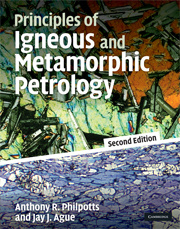Book contents
- Frontmatter
- Contents
- Preface
- Acknowledgments
- List of units
- 1 Introduction
- 2 Physical properties of magma
- 3 Intrusion of magma
- 4 Forms of igneous bodies
- 5 Cooling of igneous bodies and other diffusion processes
- 6 Classification of igneous rocks
- 7 Introduction to thermodynamics
- 8 Free energy and phase equilibria
- 9 Thermodynamics of solutions
- 10 Phase equilibria in igneous systems
- 11 Effects of volatiles on melt equilibria
- 12 Crystal growth
- 13 Isotope geochemistry related to petrology
- 14 Magmatic processes
- 15 Igneous rock associations
- 16 Metamorphism and metamorphic facies
- 17 Deformation and textures of metamorphic rocks
- 18 Graphical analysis of metamorphic mineral assemblages
- 19 Geothermometry, geobarometry, and mineral reactions among solid solutions
- 20 Mineral reactions involving H2O and CO2
- 21 Material transport during metamorphism
- 22 Pressure–temperature–time paths and heat transfer during metamorphism
- 23 Origin of rocks
- Answers to selected numerical problems
- References
- Index
2 - Physical properties of magma
- Frontmatter
- Contents
- Preface
- Acknowledgments
- List of units
- 1 Introduction
- 2 Physical properties of magma
- 3 Intrusion of magma
- 4 Forms of igneous bodies
- 5 Cooling of igneous bodies and other diffusion processes
- 6 Classification of igneous rocks
- 7 Introduction to thermodynamics
- 8 Free energy and phase equilibria
- 9 Thermodynamics of solutions
- 10 Phase equilibria in igneous systems
- 11 Effects of volatiles on melt equilibria
- 12 Crystal growth
- 13 Isotope geochemistry related to petrology
- 14 Magmatic processes
- 15 Igneous rock associations
- 16 Metamorphism and metamorphic facies
- 17 Deformation and textures of metamorphic rocks
- 18 Graphical analysis of metamorphic mineral assemblages
- 19 Geothermometry, geobarometry, and mineral reactions among solid solutions
- 20 Mineral reactions involving H2O and CO2
- 21 Material transport during metamorphism
- 22 Pressure–temperature–time paths and heat transfer during metamorphism
- 23 Origin of rocks
- Answers to selected numerical problems
- References
- Index
Summary
Introduction
Igneous rocks are formed from molten material known as magma, which usually consists of a solution of the Earth's most abundant elements: oxygen and silicon with smaller amounts of aluminum, calcium, magnesium, iron, sodium, and potassium. Robert Bunsen (1851), of “Bunsen burner” fame, was the first to recognize that magmas were actually “solutions” no different from those of salts in water, except that they were hotter. Most magmas are silicate melts, but rarer ones contain little or no silica and, instead, are composed essentially of calcium carbonate, sulfide, or iron oxide. The major elements of common magmas combine, on cooling, to form the so-called rock-forming minerals: quartz, feldspars, feldspathoids, pyroxenes, olivine, and, when water is present, amphiboles, and mica. In addition, common accessory minerals, such as iron–titanium oxides, apatite, zircon, and sulfides, form from minor magmatic constituents (Fe3+–Ti, P, Zr, and S, respectively) that do not readily enter the structures of the major rock-forming minerals.
The history of an igneous rock begins with the formation of magma at some depth in the Earth. The composition of the magma is determined by the chemical and mineralogical composition of the rock in the source region and by the process of melting. When sufficient melt has formed and coalesced, buoyancy causes it to rise. Further chemical modifications may occur during this period of transport.
- Type
- Chapter
- Information
- Principles of Igneous and Metamorphic Petrology , pp. 19 - 27Publisher: Cambridge University PressPrint publication year: 2009



